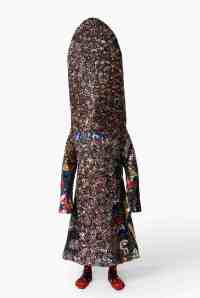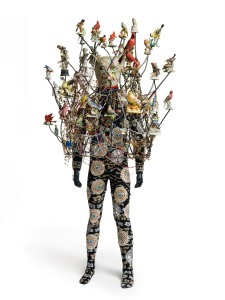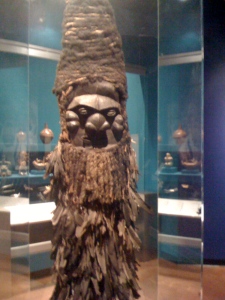“Nick Cave at The Fowler Museum,” Artillery Magazine, March / April 2010, Vol. 4, Issue 4, 46.
When it comes to art, I’m a little wary of audience participation, as it too often seems manipulative and irritatingly compulsory, like Jr. High gym class. But when it comes to Nick Cave’s Soundsuits, made of sumptuous sequins, buttons, streamers, and knit frilly things, I’m game. I want to dance around in all of them, especially the sparkly ones – and I’m not alone. During a recent trip to Cave’s stunning, yet somewhat imperfect, exhibition at The Fowler Museum on UCLA’s campus, I overheard “I want to wear that” from so many fellow viewers, that it became the show’s mantra. I’ve never seen an audience, including myself, so to literally ready to “get into the work.”Cave’s best pieces are activated by unmatched hanger appeal. One look is as follows: An eight-foot tall ankle-length loose dress, long sleeves, no neck, the shoulders extending upwards, covering the face, forming a peak, like a papal hat, or a dildo – all covered in thousands of pearlescent buttons, surrounding thousands more rainbow sequins stitched in starbursts and swirls. The sleeves, a mélange of sequin swatches, sourced from discarded evening gowns, flare subtly at the wrists. All this sits atop flowery red and black knit leggings. This is just one of Cave’s outfits, and there are a dozen or so more in the show. Some sport long shockingly pigmented hair, like something out of a Seussian dream. Others are enclosed with branch-like metal armatures sprouting ceramic birds, children’s toys, and metal flowers. Often posed in contemplative, contrapposto stances, sometimes with arms interlocked behind their backs, their faces covered, these motionless spirits stare back at you with a kind of authority, not necessarily ominous, but commanding, proud to the point of being a little intimidating, and undeniably surreal.

Soundsuit, 2007 Fabric with appliqué of found sequined material, beading, buttons, embroidery, knitted yarn, metal armature 98h x 29w x 18.5d in. Courtesy of the Artist and Tiago Ltd/Tiqui Atencio
Yet, for a show populated by Soundsuits, the exhibition is conspicuously silent, save the soundtrack from a three-channel video where a performer (presumably the artist, himself an Alvin Ailey-trained dancer) contorts his or her body to manifest the click clack, swooshes, bangs and clangs that the outfits are meant to produce. I wish the exhibition contained more video documentation like this. Most of Cave’s choreographed numbers available on the Internet, and the one he orchestrated for a special event in The Fowler’s atrium, primarily consist of a dozen or so dancers wearing billowing plastic streamer costumes like gigantic cheerleader pompoms. If only Cave’s more delicate beaded and sequined costumes were given over to a large dance ensemble and choreographed with such enthusiasm. That said, the exhibition’s silence isn’t flawed: it underscores the inherent possibility each suit embodies. In front of one outfit, a jumpsuit made of collaged potholders surrounded by a swarm of children’s noisemakers, the suit’s concomitant clamor seems achingly close, as if it were on the verge of coming to life.
Unfortunately, the show does open with an off-pitch overture: a life-size bear covered in a patchwork of bright striped sweaters, an obvious nod to UCLA’s Bruin mascot. The glorified stuffed-animal theme is repeated later with a collection of similarly outfitted dam-building beavers. Enough festooned taxidermal creations populate today’s art world to constitute an unfortunate trend, and Cave’s don’t improve the menagerie. They come off narratively dead in the water, and consequentially detract from the otherworldly Soundsuits.

Polar Bear, 2009 Foam taxidermy models,appliquéd found knitted and crocheted fabric 96h x 30w x 45d in. Photo: Ira Schrank
Because the show is installed at The Fowler, Cave’s work finds itself in an apropos tête-à-tête with the museum’s permanent collection of celebratory artifacts and artwork from non-Western cultures. Seeing a 19th century mask from New Caledonia, Melanesia adorned with feathers and a totemic mass of human hair, one can only draw parallels with Cave’s own torpedo-shaped getups and hair-draped outfits.
While Cave is obviously influenced by the traditional materials, methods, and motivations visible in The Fowler collection, his work is in no way derivative. In fact, he touches on so many expansive themes of ornamentation, decadence, and performance that, were his work showcased alongside 17th Century portraits of French royalty, or in the Met’s Arms and Armor Gallery, or in any of New York’s legendary house drag balls, equally engaging connections and parallels would abound.
Cave’s greatest strength is no doubt his work’s ability to transport you into another world, something just beyond reality but close enough to reach out and touch. And this pleasure in looking, this desire to participate, is no small feat. Like other great memorable works of art, his Soundsuits manifest the seemingly impossible. They reach in to the imaginative infinite and bring back a reflection of our deepest desires for something undeniably sublime, brighter, more unwieldy and alive than what existed before.
©2024 Tucker Neel. All rights reserved.



